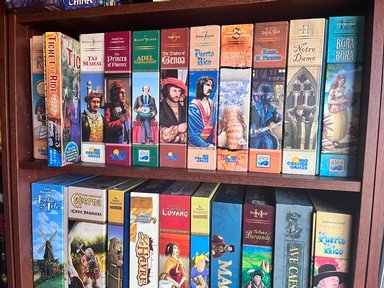Quiz Answer Key and Fun Facts
1. Debuting in 1972 was a game with a wide selection of sixteen (or 25 in the "Big" version) dice, but none of the dice are the same. And the dice feature letters. Players get three minutes to create as many words as possible. This game is...
2. Reaching shelves in 1988, and one of the few board games to feature an icosahedron, it requires you to come up with people, places, or things that fit twelve categories that begin with the same letter. This game is...
3. This game introduced in 1973 required matching 25 shapes to their corresponding holes before the sixty 60 second timer runs out. This game is...
4. Debuting in 2010, this game required teams to name 3 things relating to a singular topic. One would think the game involves eating food off the floor, but it didn't. This game is...
5. This game was introduced in 1985, and was an instant party staple. Turning Charades into an "art form", it allowed players to draw their answers in under 60 seconds, or compete against teams to draw a sketch to extract the correct answer. This game is...
6. Debuting in 1981, this game took the concept of the hourglass timer found in many games, and made it a playing piece! In fact, each player operates four timers on a game board in a competition that almost resembles keeping spinning plates on stands. The first to get their timers across to their opponent's base wins, but if they run out, you return them to the starting position. This game is...
7. Developed in 1997, this game has an unusual timer that counts up for one team while they complete a word task, and counts down while the other team attempts to repeat the task. Lettered dice are rolled for the first team, and they come up with five words, stop the timer, and the other team tries to guess the words in less time. This game is...
8. Debuting in 2013 as a board game and a phone app, this game gives you sixty seconds to get your partner say as many items in the chosen category. The board game requires a clip on your forehead to hold your card in place, and it doesn't come with a camera to film your blooper moments like the app does. This game is...
9. Reaching store shelves in 1989, this game {buzz, try again}, er, this form of entertainment gave the team up to two minutes to guess {buzz, can't say that}, umm, PREDICT what the word is on the cards. The team to gue-, sorry, PREDICT the most words wins the ga-, contest. This game is...
10. Debuting in 1994 as a board game, and streamlining into an electronic version in 2000, this game featured a timer that never revealed its random time allowed until the time was up. Players were given free reign to get their teammates to say the object, and the timer was passed onto the next team to do the same. If you held the timer when it went off, your team lost that round. This game is...
Source: Author
Spaudrey
This quiz was reviewed by FunTrivia editor
WesleyCrusher before going online.
Any errors found in FunTrivia content are routinely corrected through our feedback system.
